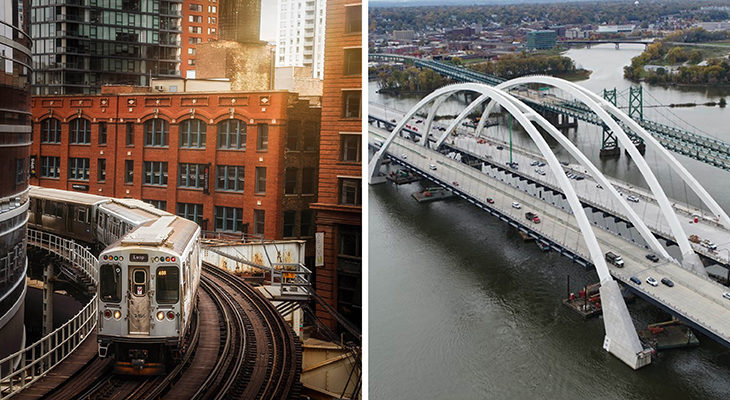
At Legat Architects’ 2021 Think Tank, Chicago and Quad Cities urban planning, transit, and development specialists discussed the role of public transportation in crawling out of the pandemic, combating disinvestment, and reconnecting the two regions.
According to the American Society of Civil Engineers’ 2021 Report Card for America’s Infrastructure, the U.S. gets a D-minus in the public transit category. The report says that a whopping 45% of Americans have no access to public transit. “Much of the existing system is aging,” states the report, “and transit agencies often lack sufficient funds to keep their existing systems in good working order.”
The pandemic compounded the problem, especially for those who suffer due to economic disparities. Low-income individuals—they rely on public transportation the most—faced obstacles in getting to their jobs or accessing heathier foods.
This disinvestment and recent struggles within the transportation sector sparked the topic for the third installment in Legat Architects’ 2021 Think Tank series. The Transportation & Municipal Design session, moderated by Legat’s Zach Campbell, brought together transportation specialists and economic development leaders in the Quad Cities region of Illinois and Iowa, as well as a Chicago-based expert in public policy, transportation, and urban planning. Among the topics the group discussed were reviving disadvantaged communities, connecting Chicago and the Quad Cities via rail, redeveloping vacant historic buildings, the transportation industry’s post-COVID struggles, and even a potential Quad Cities “Bison Bridge” that showcases—you guessed it—bison!
Jeff Nelson, chair of the American Public Transportation Association (APTA) and CEO/managing director at MetroLINK (the Illinois Quad Cities’ only public transit provider) delivered the keynote that focused on the vital role of public transit in the coming decades.
He said, “There is a growing belief that public transit has an even greater role in society to repair, strengthen, and grow the economy, to model sustainability, energy efficiency, and climate change solutions, and to advance the social politics that create greater access for all, especially in underserved communities.”
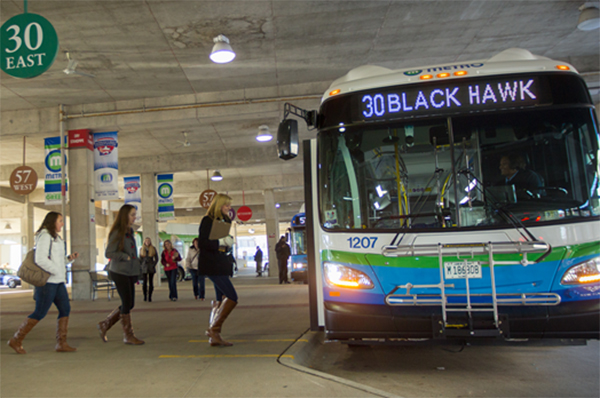
During his three decades with MetroLINK, Nelson and his organization have helped the Illinois Quad Cities evolve from a relatively overlooked area to part of a region that two million people enter each year, according to Visit Quad Cities. As the nation comes out of the pandemic and President Biden signs a $1 trillion infrastructure bill including a $39 billion investment in public transit systems, Nelson has high hopes for transportation. In the coming decades, he argues, public transit will be critical to successful urban development, with people using it to access jobs, schools, healthcare, healthy food, and many other services.
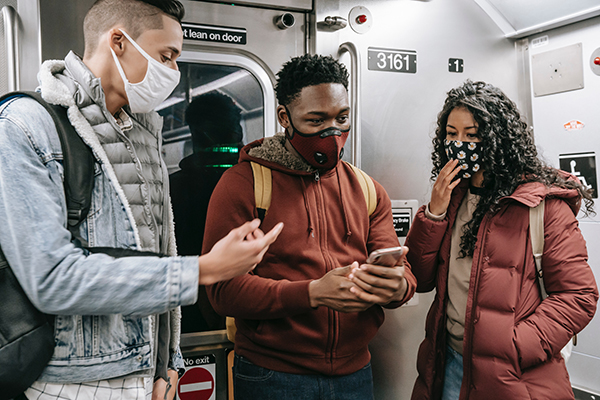
A Community Lifeline
As chair at APTA, a nonprofit international association of more than 1,500 members, Nelson has had his work cut out for him since the coronavirus struck in March 2020. During the pandemic, APTA secured almost $70 billion in relief funding to keep public transit going in terms of everything from avoiding layoffs to delivering meals to at-risk communities.
Public transit, in Nelson’s words, “provided a lifeline to communities” during the pandemic. It was especially valuable to the 50% to 60% of essential workers who use public transit. Many of these individuals live in underserved communities.
He gave several examples of how transit providers came up with solutions during the pandemic. MetroLINK, for instance, expanded its Microtransit service to offer transportation to testing sites and vaccination providers. A St. Louis grocery store, aware that many of its workers relied on public transportation, offered bus drivers gift cards as an incentive to come to work.
Although we are beginning to see a return to pre-pandemic life, Nelson recognizes the ongoing challenges that public transit faces. He said, “Public transit systems are coping with the setbacks brought on by the pandemic on top of the infrastructure challenges and racial inequities that existed long before the pandemic set in.”
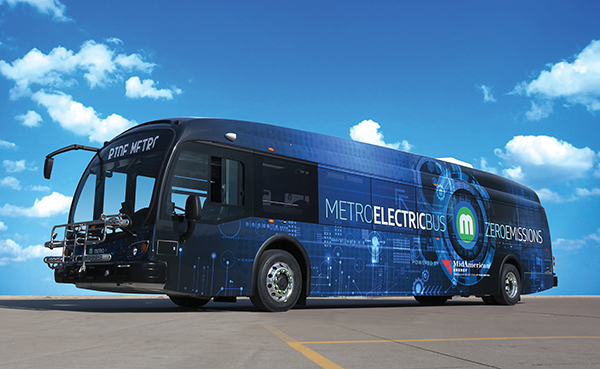
Transit As the Footprint Change
Another topic that Nelson addressed in his keynote is the critical role that public transit plays in helping our nation combat climate change and reduce our carbon emissions. “Transit is,” he said, “is that footprint change for sustainability.”
The typical bus has 40 to 60 seats, while a standard bi-level Metra (Chicago’s main commuter rail provider) car holds 140 people. Compare those occupancies to that of the typical five-seat sedan.
But public transit’s sustainability contributions go far beyond seating. MetroLINK exemplifies forward thinking when it comes to response to climate change and reducing carbon footprint. According to Nelson, the organization started moving to natural gas vehicles 20 years ago, then transitioned to electric in some vehicles. In just the last ten years, its fleet of hybrid electric buses has doubled from 7% to 19% of the total fleet. A variety of pandemic-driven factors, he added, have accelerated the movement to electric and low-emission vehicles faster than anticipated. He expects that 30% of MetroLINK’s fleet will be battery/electric within a year. Moreover, the organization is exploring ways of adding electric vehicle charging stations at key places in downtown Moline.
Public transportation can also influence sustainable change with the facilities it builds. Take MetroLINK’s Operations and Maintenance Center in Rock Island. It features a photovoltaic (i.e., solar panel) system that charges electric buses, a variable flow energy system to efficiently heat and cool the facility, and a skylight that brings natural light into the maintenance area. Repurposing vacant buildings into transit facilities also makes a strong sustainable statement. See below for Moline’s transit-oriented development called “The Q.”

Identify the Gaps and Respond
One of biggest barriers public transit faces, said Nelson, is the “systemic racism and racial inequities that are starkly visible in our transportation infrastructure.”
Those who live in lower income areas typically have longer commute times and higher transportation costs. When public transit fails to get these individuals to work, they and their communities suffer.
How can transit providers overcome these challenges? Nelson said it requires grassroots efforts … going out and talking with underserved populations to better understand and respond to their needs. MetroLINK, for example, created an app that compares the cost of ride-sharing services to those of public transit on certain routes so people can make more economic decisions.
Additionally, Nelson stressed the importance of transit providers to “think digital,” as that is how commuters will make choices, pay, and give feedback. Providers can also use technology tools to analyze data and reduce commute times in vulnerable communities with high percentages of essential workers. Microtransit, which varies its routes and schedules based on rider demand, is one option for providing better service to disadvantaged areas.
“If we get this right,” said Nelson, “we will invest in a robust transportation network for those who need it most.”
Alternative Transportation Here to Stay
Following Nelson’s keynote, several Think Tank attendees asked him about ride-share programs (e.g., Uber, Lyft) in the city of the future. He acknowledged that these modalities will play a role in most communities and pointed out the potential for organizations like his developing partnerships with such agencies.
Then there are the rentable bikes and scooters. Again, Nelson thinks they are valuable, but safety is critical. With distracted driving at an all-time high, cities need to make biking and walking safer and inform the driving public that bikes and scooters are a part of the system.
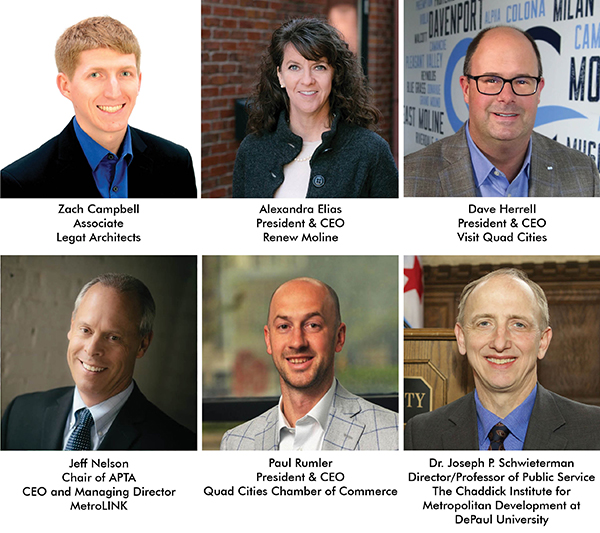
The Deck Redealt: Transportation & Municipal Design Panel
When taking the train into downtown Chicago on a recent morning, Dr. Joseph P. Schwieterman experienced something that had not happened to him in a long time: someone sat next to him. To Schwieterman, director and professor of public service at DePaul University’s Chaddick Institute for Metropolitan Development, this was a good sign—it gave him hope that downtown, despite feeling like a ghost town during the pandemic, is finally beginning to see a return of office workers.
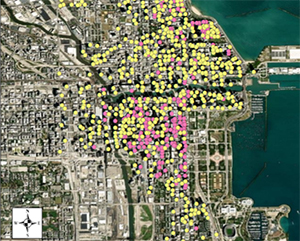
Schwieterman specializes in urban planning and the impact of transit on cities. He said that the pandemic has “redealt the deck” for major cities. On the positive side, the economy’s upward movement has given cities more spending power and strengthened the rental market with more immigrants and young people moving into cities. However, he said, the COVID-driven growth of work-from-home/flex schedules has slowed the rate at which workers are returning to their downtown offices despite increased spending power.
Each of Schwieterman’s fellow Think Tank panelists expressed optimism as the nation moves out of the pandemic. However, they also recognize the need to elevate disinvested communities. One of the most critical ways of achieving that objective, they agreed, is strengthening public transportation.
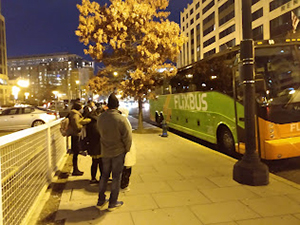
Schwieterman said that improving public transportation hinges on getting people out of their cars via increased walkability and better transit options. He referred to a graphic that his students created. It shows walk and transit scores for all 1,300 Chicago buildings over 12 stories tall. He pointed to a surge of development west of the Loop. Even though buildings in this zone are up to 15 stories tall, Schwieterman estimates that 70% of employees drive to work. This hampers walkability. He also expressed concern about how forthcoming developments south of downtown will integrate public transportation. Cities can start addressing these shortcomings by incentivizing developers to pursue better walkability scores and access to public transit.
This summer, Chicago took a step in the right direction when it welcomed FlixBus, a Germany-based company expected to offer more car-free travel options in Chicago’s neighborhoods. In October, FlixBus acquired Greyhound, which bodes well for sustainable intracity and intercity travel.
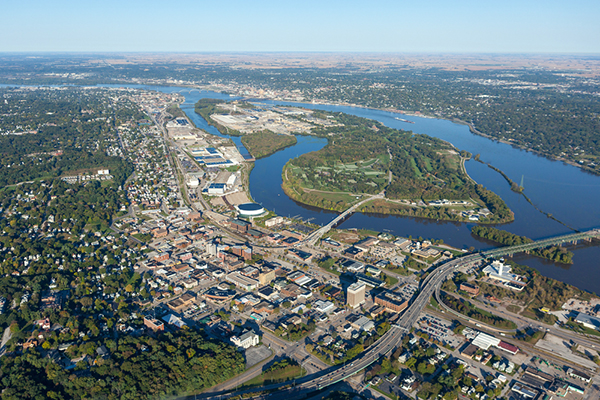
Quad Cities: Headed in the Right Direction
While economic disparity between communities has been a perennial problem in Chicago, the Quad Cities has also experienced its fair share of inequalities.
The Mississippi River unites the Quad Cities of Illinois (Moline, East Moline, Rock Island) and Iowa (Davenport, Bettendorf), creating a metropolitan region of nearly 400,000 residents. According to Paul Rumler, president and CEO of the Quad Cities Chamber of Commerce, each city in the region has had areas of disinvestment. For instance, after reaching a high point in the 1990s, parts of Rock Island suffered from a lack of investment in transportation, infrastructure, and business. Since then, the city has reclaimed its strengths with revived historic homes, new condos, and “The District,” a vibrant downtown with many entertainment and dining options. The chamber is now helping Rock Island (as well as Davenport and Bettendorf) create a business plan and sustainable building model.
Thanks to smart investments and an iconic new bridge (more below), the future looks bright for the Quad Cities region, which Rumler said was recently recognized among the most diversified economies and the top ports in the U.S. (John) Deere & Company has its global headquarters in Moline, plus operates several manufacturing facilities across the region. The Rock Island Arsenal, a U.S. Army facility, has more than 8,000 employees.
Rumler and other leaders have successfully courted other major employers. Davenport, for example, recently landed the largest economic development deal in region’s history by welcoming Amazon’s new distribution center. The facility, slated to open in summer 2022, is expected to bring 1,000 jobs to the region. Startups, such as Rock Island’s divvyDOSE, a full-service pharmacy that delivers medications, are also opening facilities in the area.
Key to unlocking the region’s full potential, according to Visit Quad Cities’ President and CEO Dave Herrell, are connectivity and mobility—transit plays a leading role in both.
Jeff Nelson added that boosting public transit is “good business.” He shared research showing that 87% of trips on public transit benefit the local economy by connecting people to jobs, shopping, healthcare, and entertainment.
However, convincing more area residents to embrace public transportation does not come without challenges. Alexandra Elias, president and CEO of Renew Moline, said that although buses are available throughout Moline, it doesn’t have larger cities’ “motivating factors” like traffic and steep parking fees.
One way to make public transit a more viable option, said Nelson, is to get people familiar with it an earlier age. Elias agreed, stating “If you know how to navigate a city on transit, you can travel anywhere and be comfortable in an urban environment.”
MetroLINK now offers unlimited access to students at three area higher education institutions, as well as to students in the Moline and Rock Island-Milan school districts. The organization has tracked a 30% increase in students using public transit in Moline since the initiative started.
Quad Cities leaders are also leveraging its location next to the river to position it as a tourist destination. According to Herrell, Viking Cruises will start porting at Quad Cities destinations in July 2022. “If you take a minimum of 10 stops with Viking along with other cruise lines,” he said, “you’re going to have low end 30 to high end 50 river cruise lines activating the Mississippi River in the area.”
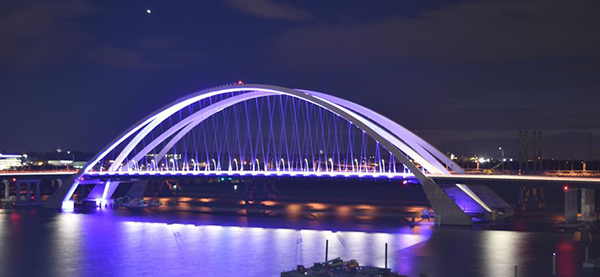
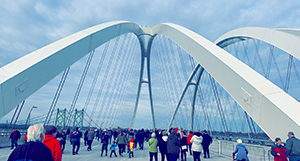
A Literal and Symbolic Bridge
Next year, construction finishes on a structure that will become as emblematic of the Quad Cities as the Willis Tower high-rise or Cloud Gate sculpture are to Chicago. The I-74 Mississippi River Bridge, scheduled to fully open in December 2021, will relieve pressure, enhance safety, and pave the way for many initiatives.
Herrell called the structure “one of the most impactful projects in our community’s history. It’s such a big part of our brand and how we’re going to shape our story in the future.”
The 85-year-old bridge it replaces, according to Rumler, has long been a stressor among Quad Cities residents and workers. He said, “People have made life decisions based on this inoperable bridge.” Seventy-five thousand people crossed the old four-lane bridge every day. An accident or breakdown would cause major delays.
Not only does the new bridge streamline traffic with four lanes in each direction, but it will also become one of the first interstate bridges with a multiuse path. At the midpoint, the 14-foot-wide path juts out and offers a scenic overlook, as well as a glass oculus that displays the river below.
Herrell said that the new bridge will support enhanced efforts to make biking a memorable part of the Quad Cities experience. His organization helped with placing bicycles in destination centers in Moline and Davenport, with Rock Island next on the docket. The free-use bicycles, combined with the new bridge, allow residents and tourists alike to easily traverse between cities and explore the region’s 100 miles of trails.
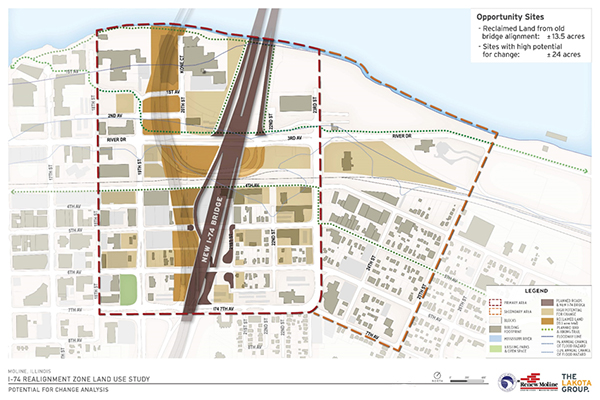
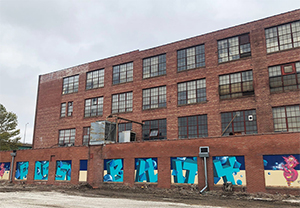
According to Elias, the new bridge also presents many development opportunity sites, including the 13.5 acres that become available with the closing of the old bridge. One building that she and others have their eyes on is the 90-year-old vacant Spiegel Building, which is the first thing travelers see when they exit the bridge on the Illinois side. The city even commissioned an artist to do an installation at the building to show its potential. He wrote the word “Possibility” on pieces of plywood that were fitted onto the building. Elias, a former San Diego resident, also sees a great deal of potential for port, recreation, and aesthetic connections to the water near the bridge.
As construction of one Quad Cities bridge wraps up, leaders are already envisioning another. The proposed “Bison Bridge” would repurpose the 55-year-old I-80 bridge. The creatures grazing on the bridge would make it a park destination. Rumler said the concept is getting traction and starting a national conversation. Watch a promotional video (courtesy Bison Bridge Foundation) for the Bison Bridge:
Harrell said, “The project reinforces how you can flip the script and repurpose an asset to create a sustainable model that future generations can enjoy.”
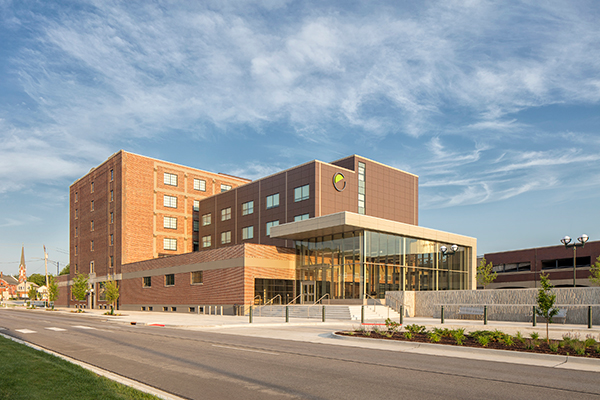
From Chi-Town to the QC: A Return to Passenger Rail
Ever since the Chicago Rock Island Railroad ceased operations in the late 1970s, the Quad Cities has dreamed of reconnecting to Chicago via passenger rail. Such a connection would boost the local economy by attracting everyone from tourists and students to businesspeople and new residents.
In 2018, the Quad Cities celebrated a huge step in that direction with the completion of The Q. The multimodal facility, designed by Legat Architects, transforms a 100-year-old warehouse into a grand station, the 96-room Element Moline hotel, and retail/restaurant tenants. The Q’s location in the heart of downtown Moline and next to MetroLINK’s Centre Station reinforces its role as a transportation hub. The Mississippi River flows less than a quarter mile to the north and more than 2,000 employees are within walking distance of the site.
The facility, achieved with the cooperation of many agencies and supported with numerous grants, exemplifies how public-private partnerships can improve transit access and spur economic development.
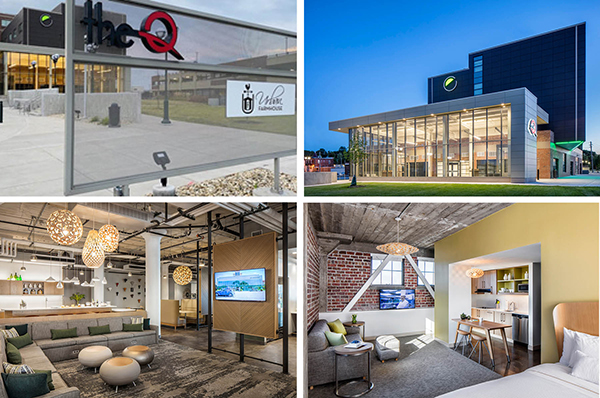
Nelson said, “The City of Moline and MetroLINK did not envision the station to be a standalone project with church pews and a Coke machine in the back, but rather part of a mixed-use, transit-oriented development that would bring additional amenities to residents and tourists of Moline, as well as additional revenue for the city.”
In 2020, construction completed on a skywalk connection between The Q and Centre Station. Among the transportation modes the facilities serve are buses, personal vehicles, bicycles, passenger trains, taxis, passenger ferry boats, and foot traffic, along with connections to the nearby Quad Cities International Airport.
Just when will the Quad Cities reconnect to Chicago? The answer is not clear. However, the Think Tank panelists (and many other decisionmakers) are putting forth their best efforts to achieve the goal. Moreover, according to Schwieterman, non-business travel on Amtrak is expected to exceed pre-pandemic levels by 2024—good news for the QC/Chicago connection.
One thing Nelson is sure of is that “when the first train rolls into the station, Moline will be ready.”
Prosperity, Progress, and Freedom
What does the future hold for public transportation in the U.S? Nelson is optimistic—he believes that the investment in the nation’s transportation infrastructure will improve everything from climate change response and racial equity to economic growth.
Getting there, he said, requires that transit and community leaders put their heads together and break down the silos that have restrained growth of public transportation. Another challenge involves educating not just the general public, but also designers and decisionmakers about making streets accessible to all. He encourages these individuals to reach beyond their own means of transportation and experiment with different modes.
“There is nothing more fundamental to the human spirit than the need to be mobile,” he said. “It is a force that sparks our imagination and opens pathways to life-changing opportunities. Mobility propels prosperity, progress, and personal freedom.”
Contact us with your question on transit/mixed-used facilities or comment below to share your thoughts on this post.
Lead photos used with permission from Trace Hudson (left) and Iowa DOT (right).


